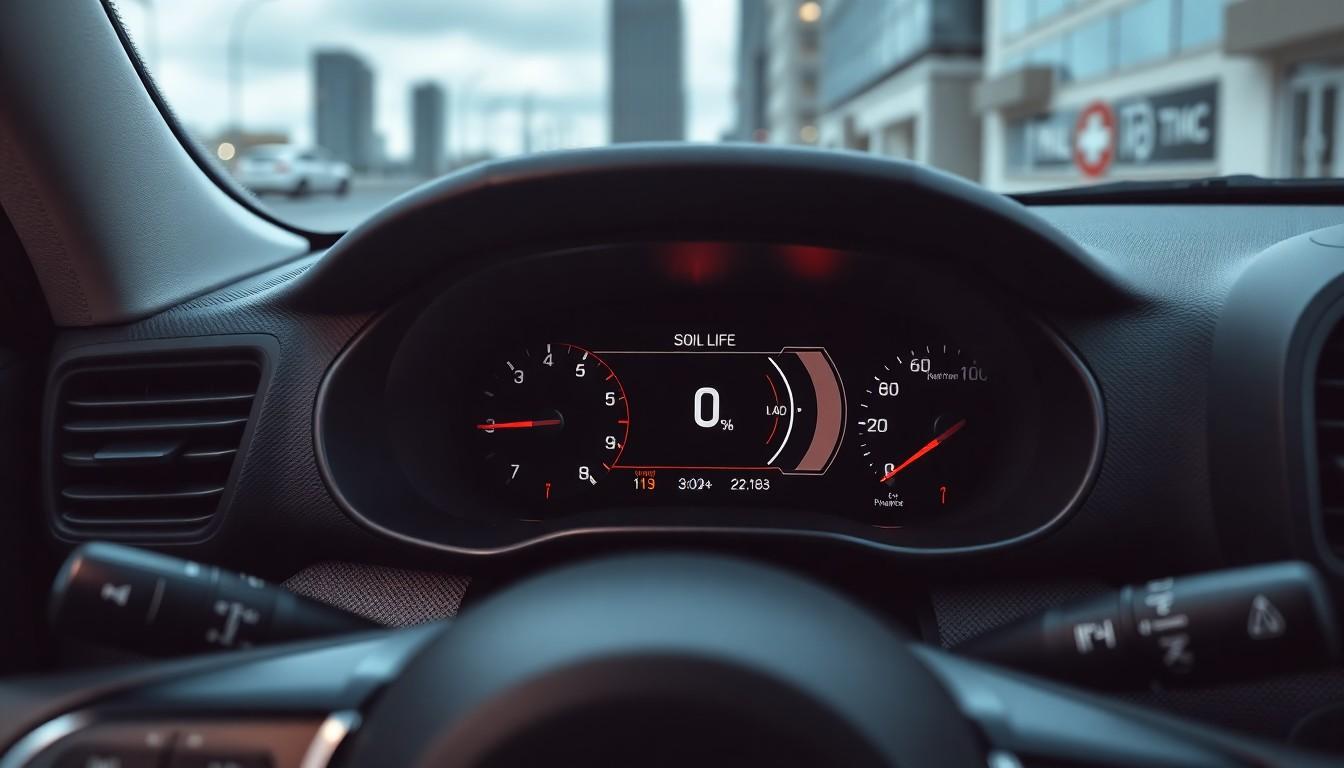Maintaining your Kia Soul’s oil change schedule is crucial for keeping your vehicle running smoothly. But after that fresh oil change, you’ll need to reset the oil life indicator to ensure accurate maintenance tracking. We’ve noticed many Kia Soul owners struggle with this simple yet important task.
We’ll walk you through the straightforward process of resetting your Kia Soul’s oil life indicator in this guide. Whether you’re a new Kia owner or simply need a quick refresher, our step-by-step instructions will help you complete this essential maintenance task in just minutes. No more warning lights, no more confusion – just a properly maintained vehicle ready for the road ahead.
Understanding Oil Life in Your Kia Soul
Your Kia Soul’s oil life indicator monitors engine oil condition and alerts you when it’s time for an oil change. This system calculates oil deterioration based on driving conditions, engine revolutions, and mileage since the last reset.
Fresh engine oil lubricates vital components, reduces friction, helps cool the engine, and removes contaminants. Over time, oil breaks down from heat, pressure, and accumulated debris, becoming less effective at protecting your engine.
The oil life monitoring system in Kia Souls doesn’t physically test the oil; rather, it uses an algorithm that factors in:
- Total miles driven since the last reset
- Engine temperature variations
- RPM ranges during operation
- Number of cold starts
- Highway versus city driving patterns
Most Kia Souls display oil life as a percentage on the instrument cluster. At 100%, the oil is fresh, while 0% indicates an immediate change is necessary. Kia typically recommends changing oil when the indicator reaches 15% or displays a service reminder.
Regular oil changes at manufacturer-recommended intervals protect your Soul’s engine from premature wear and potential damage. The oil life indicator helps optimize maintenance timing based on your exact driving habits rather than relying solely on arbitrary mileage intervals.
Why Resetting Oil Life Is Important

Resetting your Kia Soul’s oil life indicator ensures accurate maintenance tracking for your vehicle. The system relies on this reset to properly calculate when your next oil change is due, preventing potential engine damage from overdue service intervals. Many drivers overlook this crucial step after an oil change, compromising their vehicle’s monitoring system effectiveness.
False alerts become a common issue when the oil life indicator isn’t reset after service. Your dashboard may continue displaying maintenance reminders or warning lights even though having fresh oil, creating unnecessary confusion about your vehicle’s actual condition. These misleading alerts might cause you to ignore genuine warnings in the future.
Maintaining your vehicle’s warranty requires proper documentation of regular maintenance. Kia’s warranty terms often stipulate adherence to recommended service intervals, including oil changes. The reset process creates an electronic record that helps prove you’ve followed appropriate maintenance procedures if warranty claims arise.
Engine performance depends significantly on regular oil changes and proper tracking. Fresh engine oil lubricates vital components, reduces friction, and removes harmful contaminants. The reset function optimizes this tracking based on your exact driving patterns rather than arbitrary mileage intervals, extending your engine’s lifespan and improving overall performance.
How to Reset Oil Life on Kia Soul Models

Resetting the oil life indicator on your Kia Soul varies depending on the model year. The process involves handling through the dashboard menu system using steering wheel controls to access and reset the service interval settings.
Resetting Oil Life on 2014-2019 Kia Soul
Kia Soul models manufactured between 2014 and 2019 follow a straightforward reset procedure that takes less than a minute to complete. Turn the ignition to the “ON” position without starting the engine to display the service message on your dashboard. Navigate through the menu using the steering wheel buttons – specifically on 2014 models, press the upper button (paper icon) repeatedly until you reach the “Service Required” option. Select this option by pressing the button down, which automatically resets the oil life indicator to 100%.
Resetting Oil Life on 2020 and Newer Kia Soul Models
The reset process for 2020 and newer Kia Soul models includes additional steps that vary slightly by year. For 2020-2021 models, start with the ignition in the “ON” position or with the engine running. Press the information button on your steering wheel to highlight “User Settings,” then scroll down to “Service Interval” and select it. Navigate to the screen showing the mileage and time before your next service is due. Press and hold the “OK” button until you see “Reset Time and Distance,” then select “Yes” to complete the reset.
The 2022 Kia Soul requires pressing the menu button on the steering wheel to access “User Settings” (marked by a gear symbol). Scroll down to select “Service Interval,” navigate to “Reset,” and select it. You’ll need to confirm by choosing “Reset Time and Distance” followed by “OK.”
For the 2023 Kia Soul, turn on the ignition without starting the vehicle. Use the menu button on your steering wheel to access “User Settings” (gear symbol), then select “Convenience” and scroll down to “Service Intervals.” Choose “Reset,” then confirm by selecting “Reset Time and Distance” and “Yes” to finalize the reset process.
Common Issues When Resetting Oil Life

Resetting your Kia Soul’s oil life indicator can sometimes present challenges even when following the correct steps. Many owners encounter several common obstacles during this process. Understanding these potential issues helps you troubleshoot and successfully complete the reset procedure.
Incorrect Button Sequence
Pressing buttons in the wrong order often prevents successful oil life resets in Kia Souls. The dashboard system requires exact navigation paths that vary by model year. For instance, 2020-2023 models need you to navigate through “User Settings” or “Convenience” before reaching “Service Intervals.” Following the exact sequence for your particular model year ensures the reset option appears correctly.
Ignition Position Problems
The ignition must be in the ON position without the engine running during the reset process. Many reset attempts fail because drivers either have the engine running or haven’t turned the key far enough to activate the dashboard display. This crucial prerequisite applies to all Kia Soul models regardless of year, ensuring the vehicle’s computer system can access and modify the maintenance settings.
Menu Navigation Confusion
Finding the right menu path creates frequent frustration for Kia Soul owners. The menu structure can seem unintuitive, particularly in newer models with more complex displays. The correct path typically involves selecting “User Settings,” then “Convenience,” followed by “Service Intervals” in 2020-2023 models. Earlier models like the 2014 Soul require scrolling to the “Service Required” option using the steering wheel buttons.
Missing Reset Confirmation
Failing to confirm the reset represents another common oversight. After selecting the reset option, the system requires additional confirmation by selecting “Yes” or an equivalent option. Many owners exit the menu prematurely, thinking the process is complete when it actually hasn’t been finalized. Always verify the reset has been confirmed by checking that the service indicator returns to 100% or disappears entirely.
System Glitches and Technical Issues
Electronic dashboard systems occasionally experience glitches that prevent normal operation. Unresponsive buttons, frozen screens, or menu options that don’t appear as expected can all interrupt the reset process. When encountering these technical issues, turning the ignition off completely for 30 seconds before trying again often resolves temporary system hiccups.
Model Year Variations
Differences between model years create confusion when following generic instructions. The 2014 Kia Soul uses a simpler reset process with fewer menu options compared to the more complex procedure for 2020-2023 models. Always verify you’re following instructions exact to your vehicle’s exact year to avoid wasted time handling menus that don’t exist in your model.
Maintenance Schedule and Oil Change Intervals

Kia Soul owners should follow a consistent maintenance schedule to ensure optimal vehicle performance and longevity. Regular oil changes represent one of the most critical aspects of this maintenance routine. Kia typically recommends changing your Soul’s oil every 5,000 to 7,500 miles under normal driving conditions.
Driving habits significantly impact how frequently you’ll need oil changes. Those who regularly drive in severe conditions—such as stop-and-go city traffic, extreme weather environments, or frequent short trips—might need more frequent oil changes, potentially as often as every 3,500 miles.
Beyond oil changes, your Kia Soul maintenance schedule includes:
- Tire rotations every 5,000 to 8,000 miles to ensure even wear
- Brake pad inspections every 10,000 to 15,000 miles for safety
- Spark plug replacements between 30,000 to 100,000 miles (varies by plug type)
- Regular fluid level checks of transmission fluid, coolant, and brake fluid
Understanding your exact model year’s requirements proves essential for maintaining warranty coverage and preventing premature wear. The owner’s manual contains detailed information customized to your particular Kia Soul, including any model-exact variations in service intervals.
Many newer Kia Soul models feature an oil life monitoring system that tracks various factors affecting oil condition. This system analyzes driving patterns, engine temperatures, and mileage to provide a more personalized maintenance schedule than rigid mileage-based intervals alone.
Consistently following these maintenance guidelines helps preserve your engine’s health and supports optimal fuel efficiency. Properly maintained vehicles typically experience fewer mechanical issues and enjoy extended lifespans compared to neglected counterparts.
Tips for Extending Your Kia Soul’s Oil Life

Regular Oil Changes
Regular oil changes serve as the foundation for your Kia Soul’s engine health. Following the manufacturer’s recommended interval of 5,000 to 7,500 miles keeps your engine running smoothly and prevents premature wear. This schedule varies depending on your exact driving conditions, with more frequent changes needed for stop-and-go traffic or extreme temperature environments.
Use High-Quality Oil
High-quality oil makes a important difference in your Kia Soul’s performance and longevity. Kia-recommended oil types provide optimal protection for your engine’s components and maintain proper viscosity across temperature ranges. Premium synthetic oils often offer enhanced protection against sludge formation and extend the periods between oil changes.
Check and Maintain Other Fluids
Fluid maintenance goes beyond just oil changes for maximum engine protection. Coolant prevents overheating and protects against freezing in winter conditions. Transmission fluid ensures smooth gear shifting and prevents internal damage. Brake fluid maintains proper stopping power and prevents brake system corrosion that could lead to costly repairs.
Drive Smoothly
Driving habits directly impact your oil’s lifespan and effectiveness. Rapid acceleration forces the engine to work harder, degrading oil quality faster. Hard braking increases engine stress and overall wear on components. Avoiding excessive idling prevents oil contamination and maintains better fuel economy over time.
Filter Maintenance
Oil filters play a crucial role in protecting your Kia Soul’s engine from contaminants. Replacing the filter during each oil change ensures clean oil circulates throughout the engine. Quality filters trap more particles and maintain better flow rates than budget alternatives. Clean filters help maintain proper oil pressure throughout the entire engine system.
Monitor Driving Conditions
Driving conditions determine how quickly your oil breaks down and loses effectiveness. Frequent short trips prevent the oil from reaching optimal operating temperature. Towing heavy loads creates additional heat that accelerates oil degradation. Dusty or sandy environments introduce more particulates that compromise oil quality. Adjusting your maintenance schedule based on these factors helps maintain optimal engine protection between service intervals.
Conclusion
Resetting your Kia Soul’s oil life indicator is a simple yet crucial step in maintaining your vehicle’s health. We’ve walked through the model-exact steps needed to properly reset this system after each oil change.
Remember that this reset isn’t just about clearing a dashboard light—it’s about ensuring your vehicle’s monitoring system accurately tracks oil condition based on your unique driving habits.
By following our guide for your exact Kia Soul model year and maintaining a regular service schedule, you’ll protect your engine components, potentially extend your vehicle’s lifespan, and maintain warranty coverage. Taking these few minutes after each oil change will help keep your Soul running smoothly for years to come.
Frequently Asked Questions
How often should I change the oil in my Kia Soul?
For normal driving conditions, change your Kia Soul’s oil every 5,000 to 7,500 miles. If you frequently drive in severe conditions (extreme temperatures, stop-and-go traffic, or dusty environments), consider changing it more often. Newer models with oil life monitoring systems can provide personalized maintenance schedules based on your specific driving patterns.
Why is it important to reset the oil life indicator after an oil change?
Resetting the oil life indicator ensures accurate maintenance tracking and prevents false alerts about your vehicle’s condition. This step helps maintain your warranty by documenting regular service, optimizes tracking based on your driving patterns, and prevents potential engine damage from overdue service intervals. Many drivers overlook this crucial step, leading to confusion about their vehicle’s maintenance needs.
How do I reset the oil life indicator on a 2014-2019 Kia Soul?
For 2014-2019 Kia Soul models, press the MODE button on your steering wheel until you reach the Service Mode. Navigate to the Oil Life or Service menu using the arrow buttons. Press and hold the OK or SET button for about 3 seconds until the system confirms the reset. The entire process takes less than a minute.
What’s the reset process for 2020 and newer Kia Soul models?
For 2020+ Kia Soul models, turn the ignition to ON (don’t start the engine). Press the MODE button to access the LCD screen menu. Navigate to “User Settings” using the arrow buttons. Select “Utility” and then “Service Interval.” Choose “Reset” and confirm your selection. The oil life indicator will reset to 100%.
What common issues might I encounter when resetting the oil life indicator?
Common issues include using incorrect button sequences, having the ignition in the wrong position, confusion with menu navigation, missing the reset confirmation step, and occasional system glitches. Make sure to follow the exact steps for your specific model year and ensure the ignition is in the correct position during the reset process.
What factors affect my Kia Soul’s oil life?
Your Kia Soul’s oil life is affected by total miles driven, engine temperature variations, RPM ranges, number of cold starts, and driving patterns. The oil life monitoring system tracks these factors to determine when an oil change is needed. Severe driving conditions like extreme temperatures, frequent short trips, and heavy loads can significantly reduce oil life.
When does Kia recommend changing the oil based on the indicator?
Kia recommends changing your Soul’s oil when the oil life indicator reaches 15% or displays a service reminder. At this point, the oil has degraded significantly but still provides adequate protection. Waiting until 0% could potentially damage your engine as the oil may no longer provide sufficient lubrication and protection.
How can I extend my Kia Soul’s oil life?
Extend your Kia Soul’s oil life by using high-quality oil that meets manufacturer specifications, avoiding rapid acceleration and excessive idling, regularly replacing air and oil filters, maintaining proper fluid levels, and following recommended maintenance schedules. Also, allow your engine to warm up properly before driving in cold weather and avoid frequent short trips when possible.
What other maintenance should I perform along with oil changes?
Along with oil changes, regularly rotate your tires (every 5,000-7,500 miles), inspect brake pads (every 10,000 miles), replace spark plugs (every 100,000 miles for most models), and check all fluid levels (coolant, transmission, brake, power steering). Also inspect belts, hoses, and battery connections during routine maintenance to prevent unexpected breakdowns.
Why is fresh engine oil crucial for my Kia Soul?
Fresh engine oil is essential because it lubricates moving components to reduce friction and wear, helps cool the engine by transferring heat away from critical parts, removes contaminants and debris that could cause damage, and improves fuel efficiency. Regular oil changes are the most cost-effective way to extend your engine’s lifespan and maintain optimal performance.

